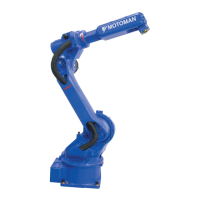4-5
168542-1CD
168542-1CD
MLX200 Software and
Operations
4 MLX200 Programming Guide
4.1 Developing a Simple Application
These buttons along with the UserStepAndContinue variable can be used
to step through an application program by writing the application as shown
in Fig.4-6 "UserProgramStepContinue Functionality in Application Logic".
Here, the application will only move to the next step if the
UserStepAndContinue variable is turned on. Thus, the application will run
normally when the Start button is pressed, but will stop at the end of the
current rung when the Step Pause button is pressed. By pressing Step
Continue, the program will start to execute normally again. Thus, toggling
this button will allow a user to step through their application code.
Fig. 4-6: UserProgramStepContinue Functionality in Application Logic
4.1.4 Teaching Points in User Frames
The previous sections described how to teach points in World
Coordinates. However, it is often useful to teach points relative to a
defined User Frame. For example, a User Frame could be attached to the
corner of a pallet and then a sequence of motions could be taught relative
to that frame. Then, the same program could be executed on another
pallet by just changing the active User Frame.
To teach points relative to a User Frame, you must first define and activate
a User Frame. A User Frame can be defined through the HMI screens
described in Section 3.4.7 “Tool and User Frame Screens” on page 3-32.
A frame can be activated either through the [Set User Frame] button on
the HMI or by a call to the MLxRobotSetUserFrame instruction. After
being activated, the User Frame number should appear in the
MLX[].Robot[].ActiveUserFrameNumber [] variable which can also be
seen from the HMI.
Fig. 4-7: User Coordinate System

